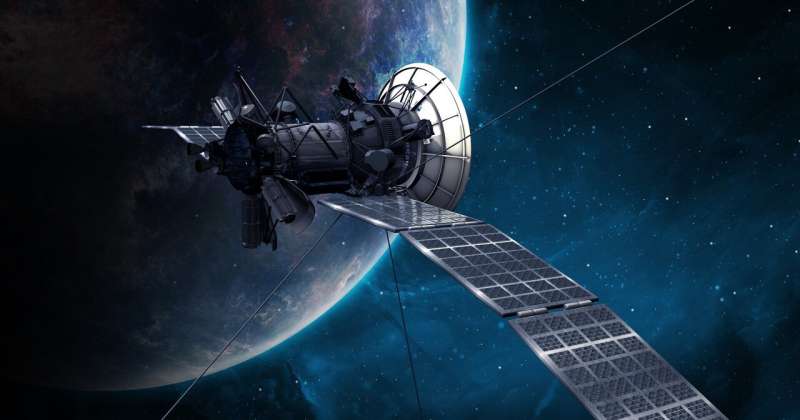Science
Scientists Achieve Breakthrough in Quantum Signal Transmission to Satellites

Recent research conducted by a team from the University of Technology Sydney has demonstrated the feasibility of transmitting quantum signals from Earth to a satellite, a concept previously deemed impractical. This significant advancement addresses major challenges in current quantum satellite communications, potentially paving the way for novel applications in secure data transmission.
The study, titled “Quantum entanglement distribution via uplink satellite channels,” was led by Professor Simon Devitt and Professor Alexander Solntsev, and published in the journal Physical Review Research. Current quantum satellites, like the Micius satellite, launched in 2016, have primarily focused on sending entangled particles of light down to ground stations. This new research expands the capabilities of quantum communications by proposing a method to send signals upward.
Traditionally, quantum satellites create entangled pairs in space, which are then transmitted to Earth. “Current quantum satellites create entangled pairs in space and then send each half of the pair down to two places on Earth—called a ‘downlink,’” explained Professor Solntsev. This process has been primarily used for cryptographic purposes, requiring only a few photons to establish a secure key. The idea of sending entangled photon pairs from the ground to a satellite had not been seriously considered due to concerns over signal loss and interference.
The research team conducted modeling to assess the viability of this uplink approach. They aimed to send two single particles of light from different ground stations to a satellite orbiting approximately 500 km above Earth at speeds nearing 20,000 km per hour. “Surprisingly, our modeling showed that an uplink is feasible,” said Professor Devitt. The team factored in real-world variables such as background light, atmospheric conditions, and potential misalignments in optical systems.
The findings suggest that testing the uplink concept could occur soon, utilizing drones or high-altitude balloons. This could facilitate the development of quantum networks spanning countries and continents, leveraging small low-orbit satellites. “A quantum internet is a very different beast from current nascent cryptographic applications,” noted Professor Devitt. “We need significantly more photons—more bandwidth—to connect quantum computers.”
The uplink method could provide the necessary bandwidth without the need for satellites to generate vast quantities of photons. Instead, a compact optical unit on the satellite could effectively interact with incoming photons and relay results, minimizing costs and size while enhancing practicality.
Looking ahead, Professor Devitt envisions a future where quantum entanglement functions similarly to electricity—an essential commodity that powers various applications. “There will be quantum devices that plug into an entanglement source as well as a power source, utilizing both to do something useful,” he stated.
This project exemplifies the collaborative efforts between the faculties of Engineering and IT and Science at UTS, showcasing how interdisciplinary cooperation can address significant technological challenges. The implications of this research extend beyond theoretical exploration, hinting at a future where quantum communications could revolutionize data security and connectivity on a global scale.
For more information, refer to the study published by S. Srikara et al in Physical Review Research.
-

 Health3 months ago
Health3 months agoNeurologist Warns Excessive Use of Supplements Can Harm Brain
-

 Health3 months ago
Health3 months agoFiona Phillips’ Husband Shares Heartfelt Update on Her Alzheimer’s Journey
-

 Science2 months ago
Science2 months agoBrian Cox Addresses Claims of Alien Probe in 3I/ATLAS Discovery
-

 Science2 months ago
Science2 months agoNASA Investigates Unusual Comet 3I/ATLAS; New Findings Emerge
-

 Science1 month ago
Science1 month agoScientists Examine 3I/ATLAS: Alien Artifact or Cosmic Oddity?
-

 Entertainment5 months ago
Entertainment5 months agoKerry Katona Discusses Future Baby Plans and Brian McFadden’s Wedding
-

 Science1 month ago
Science1 month agoNASA Investigates Speedy Object 3I/ATLAS, Sparking Speculation
-

 Entertainment4 months ago
Entertainment4 months agoEmmerdale Faces Tension as Dylan and April’s Lives Hang in the Balance
-

 World3 months ago
World3 months agoCole Palmer’s Cryptic Message to Kobbie Mainoo Following Loan Talks
-

 Science1 month ago
Science1 month agoNASA Scientists Explore Origins of 3I/ATLAS, a Fast-Moving Visitor
-

 Entertainment2 months ago
Entertainment2 months agoLewis Cope Addresses Accusations of Dance Training Advantage
-

 Entertainment3 months ago
Entertainment3 months agoMajor Cast Changes at Coronation Street: Exits and Returns in 2025









